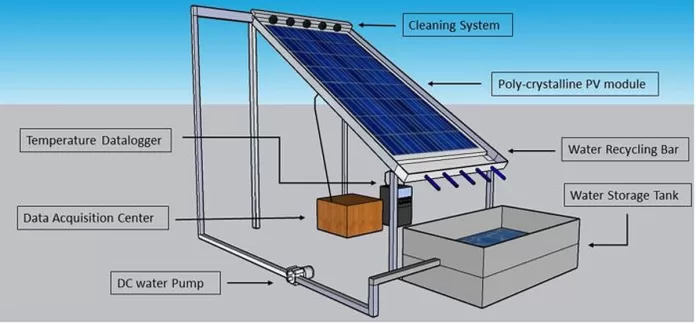Researchers at Pakistan’s National University of Sciences and Technology (NUST) have come up with a new way to clean solar PV panels that also cools them down.
The study’s lead author, Adeel Waqas, told PV magazine, “The proposed solar panel cleaning system can be easily added to both residential and commercial solar PV installations.” “The system was made to work on its own, and a microcontroller manages the cleaning process so that no human help is needed.”
The cleaning method is a steel bar that is 76.2 cm long and is attached to the top of the solar cell. It has eight flat-fan jets that spray water evenly through the front of the panel in a convex design. The fan blades are spaced 14 cm apart and can move 0.49 L/m of water. To get water into the bar, a 36-watt DC water pump is used.
Waqas said, “After cleaning, the used water is collected and put through a Whatman filter.” “This process allows 85% of the water to be reused because the water that has been cleaned is put back into the system’s tank. This method is especially useful in places where there isn’t enough water because it can recycle it.
The scientists tried their new method at an experiment set up at the NUST in Islamabad, Pakistan, in January and February for three PV systems tilted at 23, 33, and 43 degrees, respectively. “The electrical and temperature parameters were constantly monitored for 24 hours, with 1 minute breaks between each set of values,” they said, adding that the performance of the system was compared to that of a reference setup without the cleaning tech.
The researchers found that the cleaned PV panel could produce up to 13.74 percent more power at the set tilt angles than the reference panel. They also found that the water flowing over the module was able to lower its working temperature by up to 0.8 °C compared to the standard setting. “The automated cleaning system, which runs for 5 minutes a day and uses high-pressure water sprayed through flat fan nozzles, can recover up to 80% of the power lost because of dirt,” they said.
Waqas says that a Solar PV module with a cleaning system costs $65.48, while a module without a cleaning system costs around $35. “After doing the economic analysis, the cost recovered from extra power after cleaning is $0.0332 per day. This means that in Islamabad, extra cleaning system costs will pay for themselves in 2.51 years,” he said. “The cost of running the system is almost nothing because it is run automatically by an Arduino board. The proposed system is also economically feasible because it pays for itself in a short time.”





